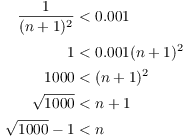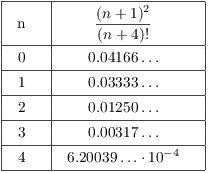If a series has only positive terms, the partial sums get larger and larger. If they get large too rapidly, the series will diverge.
However, if some of the terms are negative, the negative terms may cancel with the positive terms and prevent the partial sums from "blowing up". Here's an example.
This is the harmonic series:
![]()
We've seen that it diverges.
This is the alternating harmonic series
![]()
The alternating harmonic series converges.
I computed the ![]() ,
, ![]() , and
, and ![]() partial
sums of the harmonic series and the alternating harmonic series.
Here's what I got:
partial
sums of the harmonic series and the alternating harmonic series.
Here's what I got:

Of course, this is just numerical evidence, not a proof. However, you can see that while the partial sums of the harmonic series are getting steadily larger, the partial sums for the alternating harmonic series seem to be converging.
The pictures below show the first 20 and the first 100 partial sums of the alternating harmonic series.

Notice how the partial sums appear to converge by oscillation to a
value around 0.69.![]()
A series alternates if the signs of the terms alternate in sign. The Alternating Series Test provides a way of testing an alternating series for convergence.
Theorem. ( Alternating Series
Test) Suppose ![]() is an alternating series (so the
is an alternating series (so the ![]() 's are positive). Suppose in addition that:
's are positive). Suppose in addition that:
(a) The ![]() 's decrease.
's decrease.
(b) ![]() .
.
Then the series ![]() converges.
converges.
It is usually easy to see by inspection that a series alternates. To
check that the ![]() 's decrease, look at the
corresponding function
's decrease, look at the
corresponding function ![]() . Compute the derivative
. Compute the derivative
![]() , and use the fact that a function decreases if its
derivative is negative.
, and use the fact that a function decreases if its
derivative is negative.
![]() is the same limit
that appears in the Zero Limit Test. By itself, the condition that
is the same limit
that appears in the Zero Limit Test. By itself, the condition that
![]() is not enough
to make a series converge. (If the limit isn't 0, the Zero
Limit Test says the series diverges.) The Alternating Series Rule
augments the computation of this limit with other conditions, and all
together these conditions are enough to ensure convergence.
is not enough
to make a series converge. (If the limit isn't 0, the Zero
Limit Test says the series diverges.) The Alternating Series Rule
augments the computation of this limit with other conditions, and all
together these conditions are enough to ensure convergence.
Proof. Consider the alternating series
![]()
The ![]() partial sum is
partial sum is
![]()
The odd partial sums ![]() ,
, ![]() ,
, ![]() decrease:
decrease:

The reason is that, since the terms of the series decrease, ![]() for all k, so
for all k, so ![]() for all k. Thus
for all k. Thus
![]()
So at each step I'm subtracting a sequence of positive numbers from
![]() .
.
Moreover, the odd partial sums are all greater than 0:

The terms in parentheses are all positive, because ![]() for all k.
for all k.
Thus, the odd partial sums ![]() ,
, ![]() ,
, ![]() , ... form a decreasing sequence
that is bounded below. Therefore, they have a limit:
, ... form a decreasing sequence
that is bounded below. Therefore, they have a limit:
![]()
In similar fashion, the even partial sums ![]() ,
, ![]() ,
, ![]() , ... form an increasing sequence bounded above by
, ... form an increasing sequence bounded above by
![]() . Hence, they have a limit:
. Hence, they have a limit:
![]()
But
![]()
Then

This means that
![]()
Their common value is ![]() . Since the partial sums approach a limit, the series
converges.
. Since the partial sums approach a limit, the series
converges.![]()
Remark. A common mistake is to try to apply the conditions of the Alternating Series Rule, and then, upon discovering that some condition doesn't hold, conclude that the series diverges. The rule only says that if the conditions are true, then the series converges; it does not say what happens if the conditions are not true.
On the other hand, if ![]() , you can conclude that the series diverges,
by the Zero Limit Test.
, you can conclude that the series diverges,
by the Zero Limit Test.
Example. Apply the Alternating Series Test to
the alternating harmonic series ![]() .
.
The ![]() ensures that the terms alternate.
ensures that the terms alternate.
Let ![]() . Then
. Then ![]() , which is always negative. Since
f is always decreasing, the terms of the series decrease in
magnitude.
, which is always negative. Since
f is always decreasing, the terms of the series decrease in
magnitude.
I could also see this by graphing ![]() .
.
Note that in considering whether the terms decrease, I ignore the
![]() part --- the
part --- the ![]() .
.
Finally,
![]()
The conditions of the Alternating Series Test hold. Therefore, the
series converges.![]()
Example. Does ![]() converge or diverge?
converge or diverge?
The series alternates, and
![]()
Set ![]() . Then
. Then
![]()
Since ![]() for
for ![]() and the other
factors in the last expression are positive, I have
and the other
factors in the last expression are positive, I have ![]() and the terms of the series decrease in absolute
value. By the Alternating Series Test, the series converges.
and the terms of the series decrease in absolute
value. By the Alternating Series Test, the series converges.![]()
Example. Does ![]() converge or diverge?
converge or diverge?
This is an alternating series, though it's disguised by the absence
of the usual ![]() . But note that
. But note that
![]()
In fact, ![]() , so the series can be
rewritten as
, so the series can be
rewritten as ![]() .
.
The series alternates. If ![]() , then
, then
![]()
Hence, the terms decrease in magnitude.
Finally,
![]()
The conditions of the Alternating Series Test are satisfied. Hence,
the series converges.![]()
When a series converges, you can approximate the sum to an arbitrary degree of accuracy by adding up sufficiently many terms. How many terms do you need to add up in order to approximate the sum to within a given tolerance? When the series is an alternating series, there's an easy way to find out.

As the picture shows, the partial sums of an alternating series converge by oscillation to the actual sum. Alternate partial sums are greater than the sum, less than the sum, greater than the sum, and so on.
If ![]() is the n-th partial sum (the sum of the terms through
the n-th), the error is smaller than the next "jump". The
size of the jump from
is the n-th partial sum (the sum of the terms through
the n-th), the error is smaller than the next "jump". The
size of the jump from ![]() to
to ![]() is
is ![]() .
.
(a) The n-th partial sum of a convergent alternating series is in error by no more than (the absolute value of) the next term in the series.
(b) The actual sum of an alternating series lies between any two consecutive partial sums.
Example. Approximate ![]() using the
using the ![]() and
and ![]() partial sums.
partial sums.
I showed in the last example that this alternating series converges. Here's the sum of the first 10 terms.
![]()
The next term in the series is ![]() . Ignoring the sign, this is approximately 0.11715.
The estimate 1.15141 is in error by no more than 0.11715, around
. Ignoring the sign, this is approximately 0.11715.
The estimate 1.15141 is in error by no more than 0.11715, around ![]() .
.
In fact, more is true. The last term ![]() was subtracted, so the
estimate is too small.
was subtracted, so the
estimate is too small.
The next partial sum is too large:
![]()
The actual sum is between 1.15141 and 1.26856.![]()
Example. (a) Estimate the error if the first
100 terms of the sum ![]() are used to approximate the sum.
are used to approximate the sum.
(b) How many terms would be required to estimate the sum to within 0.001?
(a) The error in using the ![]() partial sum
is less than the absolute value of the
partial sum
is less than the absolute value of the ![]() term. Hence, the error is less than
term. Hence, the error is less than
![]()
(b) The error in using the ![]() partial sum
partial sum
![]() is less than the absolute value of the
is less than the absolute value of the ![]() term, which is
term, which is ![]() . So I want
. So I want

Now ![]() . I want the
first integer larger than this, and that is
. I want the
first integer larger than this, and that is ![]() .
.![]()
Example. Consider the convergent alternating
series ![]() .
.
Estimate the smallest value of n so that the partial sum ![]() approximates the actual value of the sum with an error of no more
than 0.001.
approximates the actual value of the sum with an error of no more
than 0.001.
The partial sum ![]() is in error by no more than the
(absolute value of the) next term, which is
is in error by no more than the
(absolute value of the) next term, which is
![]()
I want this to be no more than 0.001, so I want the smallest n such that
![]()
I can't solve this inequality algebraically, so I will use trial and error.

The first value for which the inequality holds is ![]() .
.![]()
Copyright 2019 by Bruce Ikenaga